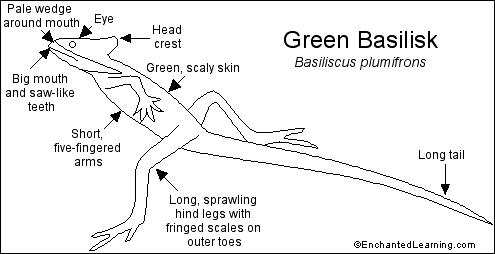
 |
| You might also like: | Lizard Printouts - AllAboutNature.com | Nutria Printout | Pupfish Printout | Giant Anteater Printout | Lizard Printout | Today's featured page: Flag of Italy |
| Lizard Printouts | EnchantedLearning.com Basilisk | Animal Printouts Label Me! Printouts |


Anatomy: Basilisks have teeth that are fused to the inner sides of their jaws. These reptiles have a long, whip-like tail, eyelids, four sprawling legs, and a body covered with overlapping scales. The body is laterally compressed (a cross-section of the body is tall and thin). The outer edges of the toes have long, fringe-like scales that help it walk on water. A large, flat, lobed crest adorns the back of the basilisk's head. Male basilisks also have a tall crest running along the back. Basilisks range from 2 to 2.5 feet (0.6 - 0.8 m) long; females are smaller than males.
Diet: Basilisks are carnivores (meat-eaters). They eat insects (like grasshoppers and crickets), arachnids (including spiders), worms, and other small animals. Like other lizards, the basilisk stores fat in its tail.
Reproduction: A female will dig a shallow trench in moist soil in which she will lay 18-20 eggs. After covering the eggs with soil, there is no more parental care. When the eggs hatch (after an incubation period of about 8 to 10 weeks), the young live in trees and eat insects that they catch themselves.
Predators: Large snakes and some large birds (like the quetzal) prey upon the basilisk.
Classification:Phylum Chordata (animals with a notochord), Subphylum Vertebrata (vertebrates), Class Reptilia (reptiles), Order Squamata (lizards and snakes), Suborder Lacertilia (lizards), Family Iguanidae, Genus Basiliscus, Species B. basiliscus (common basilisk), B. plumifrons (green basilisk), B. vittatus (brown or striped basilisk), B. galeritus (western or red-headed basilisk).
| Search the Enchanted Learning website for: |